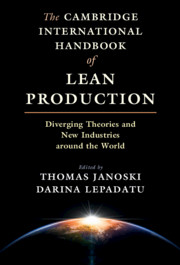 The Cambridge International Handbook of Lean Production
The Cambridge International Handbook of Lean Production Book contents
- The Cambridge International Handbook of Lean Production
- The Cambridge International Handbook of Lean Production
- Copyright page
- Dedication
- Contents
- Tables
- Figures and Sidebars
- Preface
- Acknowledgments
- Contributors
- Abbreviations
- 1 Lean Production as the Dominant Division of Labor
- Part I Theories of Lean Production
- 2 Lean Production from the View of Management Theory
- 3 Lean Production – Perspectives from its Primary Caretaker, Industrial Engineering
- 4 The Industrial Relations Perspective on Lean Systems, Workers, and Unions
- 5 Contested Views of Lean Production from the Social Sciences Perspective
- 6 The Lean Labor Process
- Part II Lean Production across Industries
- Part III Lean Production Around the World
- Name Index
- Subject Index
- References
4 - The Industrial Relations Perspective on Lean Systems, Workers, and Unions
from Part I - Theories of Lean Production
Published online by Cambridge University Press: 11 March 2021
- The Cambridge International Handbook of Lean Production
- The Cambridge International Handbook of Lean Production
- Copyright page
- Dedication
- Contents
- Tables
- Figures and Sidebars
- Preface
- Acknowledgments
- Contributors
- Abbreviations
- 1 Lean Production as the Dominant Division of Labor
- Part I Theories of Lean Production
- 2 Lean Production from the View of Management Theory
- 3 Lean Production – Perspectives from its Primary Caretaker, Industrial Engineering
- 4 The Industrial Relations Perspective on Lean Systems, Workers, and Unions
- 5 Contested Views of Lean Production from the Social Sciences Perspective
- 6 The Lean Labor Process
- Part II Lean Production across Industries
- Part III Lean Production Around the World
- Name Index
- Subject Index
- References
Summary
The impact of lean systems on workers and unions was fully intertwined with the overall attention to the rise of lean production as an alternative to Fordist mass production in the late 1980s and 1990s. With “lean” as the name given to the Toyota Production System (TPS) by MIT’s International Motor Vehicle Program in The Machine That Changed the World (Womack, Jones, and Roos 1990), the link to the global automotive industry and specifically Toyota was clear. At that stage of the industry’s globalization, the transfer of TPS outside of Japan to “transplants” in the USA and elsewhere was riveting the attention of industry executives, plant managers, investment analysts, and academics alike. Transfer of TPS/lean in such a highly unionized industry immediately necessitated dealing with issues of worker and union acceptance or rejection of that transfer, particularly given striking institutional differences between Japan and the West.
- Type
- Chapter
- Information
- The Cambridge International Handbook of Lean ProductionDiverging Theories and New Industries around the World, pp. 92 - 123Publisher: Cambridge University PressPrint publication year: 2021
References
- 1
- Cited by


